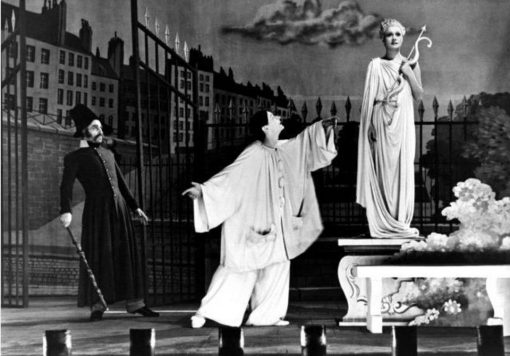1. Children of Paradise (1945)
There are hundreds upon hundreds of films that serve as the DNA for the hopeless romanticism people have for France, or more specifically, for Paris. Children of Paradise set out to portray the city and its diverse, eccentric folk in the largest cinematic terms possible. Director Marcel Carné and writer Jacques Prévert succeeded, crafting an epic of character, story, and visuals that still holds that title to this day. Children of Paradise is more of an experience than anything else, but there is still warmth and depth to the various stories that inhabit its frame. It is a fascinating ode to theater, and it is a dizzying tribute to love. There are indeed dated elements to Children of Paradise, but its energy and sincerity remain fresh after seven decades.
2. Seven Samurai (1954)
Seven Samurai on its own is flawless in every imaginable way, but it is also interesting to note the influence it has had on other things. A Bug’s Life, The Magnificent Seven, and Samurai 7 all owe Akira Kurosawa’s most famous film a debt of gratitude. There is a reason for that. It is one of the most sublimely told stories in film history. The backdrop is straightforward. Villagers being bullied and terrorized by bandits turn to rogue samurai to protect their livelihoods. That’s almost the entire core plot. However, Seven Samurai emphasizes the adage that the way the story is told is what matters. Kurosawa fills this masterpiece with incredible actors giving electrifying performances (particularly frequent collaborator Toshiro Mifune, remarkable action sequences, and a pacing that never feels like the 3+ hour running time is a drag. Choosing just one Kurosawa movie is a daunting task. Even so, in my mind, this one remains the clear winner of his filmography.
3.Umberto D (1952)
If you want to study the entire range of post-War Italian films, good luck. If you want to know where to start, Umberto D is where I would personally suggest. You don’t really need to be a history student to understand that the characters of Vittorio De Sica’s neorealist classic are struggling in the dawn of a new age. For many in Europe, to say that the end of World War II created despair and uncertainty would be an understatement. Politics are not aggressive in this film, which is why it is still so vital. Carlo Battisti as an elderly man trying to survive in bleak economic times with his loyal dog is beautiful, painfully relatable humanity. The old man is long, long gone. So is the dog. Yet our mind’s eye still reaches for them, when Battisti’s character has to decide if he can continue to care for the only thing that is keeping him alive. Umberto D has one of the best examples of rich, pure sentiment I have ever experienced.
4. The 400 Blows (1959)
Few films are more raw and honest in their depiction of childhood than François Truffaut’s The 400 Blows. One of the Truffaut’s smartest moves is in trusting so much of this compulsory film’s intended impact on the performance of young Jean-Pierre Léaud, as the child who is trying to find a balance between growing up, and understanding the larger world in increasingly tumultuous times. This is combined with exceptional, lean storytelling, and an attention to detail that demands repeat viewings. The 400 Blows is very much a time capsule, but it is another example of a film whose humanity allows it to achieve a clear-cut immortality.
5. Nosferatu (1922)
I do understand that silent films are difficult to sit through, but I can promise you that you will not be bored by even a second of one of the most enduring classics in not only the horror genre, but in all of film. The rules of atmosphere, of the boogeyman (in this case, a character so clearly based on Dracula, Bram Stoker’s widow nearly caused the film to be destroyed forever) creating at least some of his menace through facial expressions and body language, are at play here. Those rules stand today in the horror genre. Nosferatu is worth watching for the mere fact that it is a great piece of film history. It is also worth watching for the fact that the visuals and Max Schreck are as unsettling now as they were then.
What are your top five going to be?
Some of the coverage you find on Cultured Vultures contains affiliate links, which provide us with small commissions based on purchases made from visiting our site.





